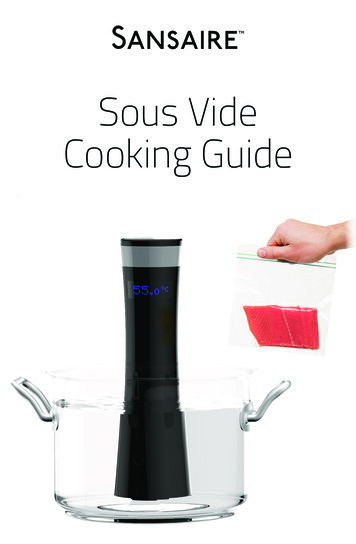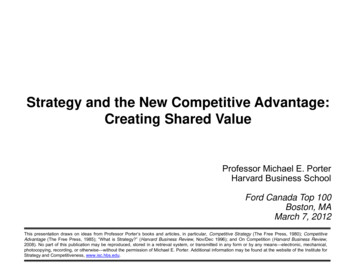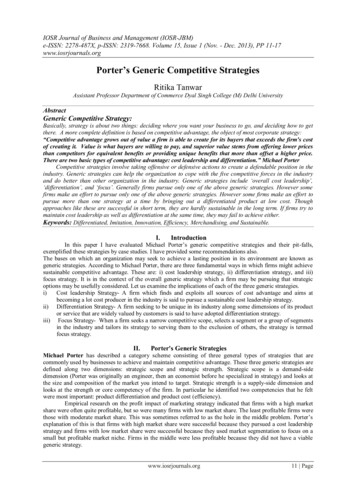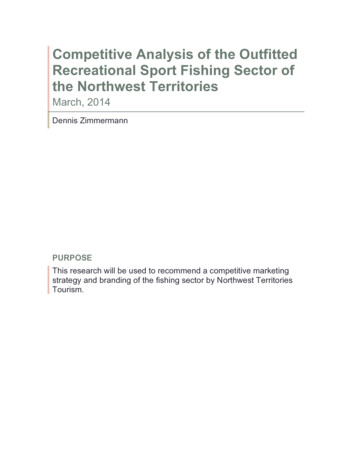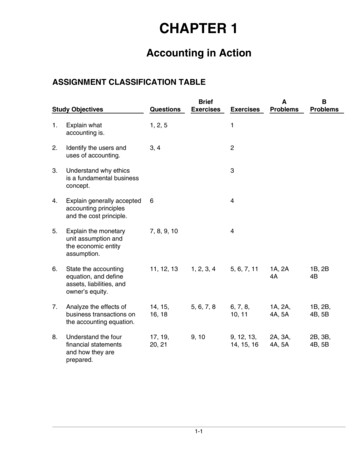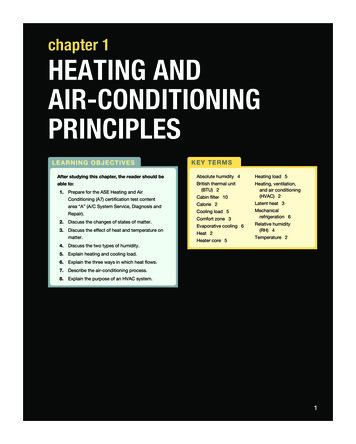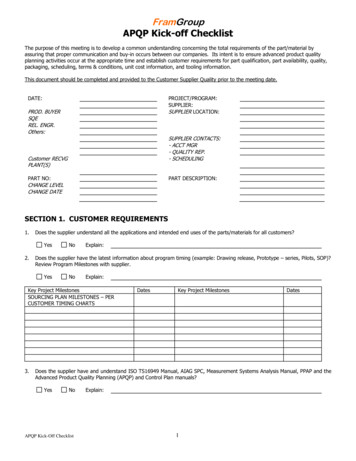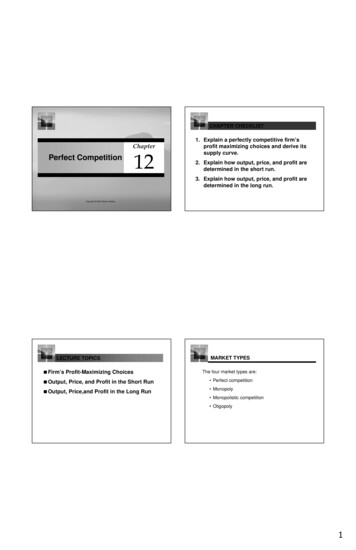
Transcription
CHAPTER CHECKLISTChapterPerfect Competition121. Explain a perfectly competitive firm’sprofit maximizing choices and derive itssupply curve.2. Explain how output, price, and profit aredetermined in the short run.3. Explain how output, price, and profit aredetermined in the long run.Copyright 2002 Addison WesleyLECTURE TOPICS Firm’s Profit-Maximizing ChoicesMARKET TYPESThe four market types are: Output, Price, and Profit in the Short Run Perfect competition Output, Price,and Profit in the Long Run Monopoly Monopolistic competition Oligopoly1
MARKET TYPES Perfect CompetitionPerfect competition exists when:MARKET TYPES Other Market TypesMonopoly is a market for a good or service that has Many firms sell an identical product to manybuyersno close substitutes and in which there is one supplierthat is protected from competition by a barrierpreventing the entry of new firms. There are no restrictions on entry into (or exitfrom) the market.Monopolistic competition is a market in which a Established firms have no advantage over newfirms. Sellers and buyers are well informed aboutprices.12.1 FIRM’S PROFIT-MAXIMIZING CHOICES Price Takerlarge number of firms compete by making similar butslightly different products.Oligopoly is a market in which a small number offirms compete.12.1 FIRM’S PROFIT-MAXIMIZING CHOICES Revenue ConceptsA price taker is a firm that cannot influence the priceof the good or service that it produces.In perfect competition, market demand and marketsupply determine price.The firm in perfect competition is a price taker.A firm’s total revenue equals the market pricemultiplied by the quantity sold.A firm’s marginal revenue is the change in totalrevenue that results from a one-unit increase in thequantity sold.Figure 12.1 on the next slide illustrates the revenueconcepts.2
12.1 FIRM’S PROFIT-MAXIMIZING CHOICESIn part (a), market demandand market supply determinethe price at which each firmcan sell its output.12.1 FIRM’S PROFIT-MAXIMIZING CHOICESIn part (c), if Dave sells 10cans of syrup a day, his totalrevenue is 80 a day at pointA.12.1 FIRM’S PROFIT-MAXIMIZING CHOICESIn part (b), the market pricedetermines the firm’s marginalrevenue and the demandcurve for its output.12.1 FIRM’S PROFIT-MAXIMIZING CHOICESDave’s total revenue curve isTR.The table shows thecalculations of TR and MR.3
12.1 FIRM’S PROFIT-MAXIMIZING CHOICES Profit-Maximizing OutputAs output increases, total revenue increases.12.1 FIRM’S PROFIT-MAXIMIZING CHOICESOne way to find the profit-maximizing output is to usea firm’s total revenue and total cost curves.But total cost also increases.Profit is maximized at the output level at which totalrevenue exceeds total cost by the largest amount.Because of decreasing marginal returns, total costeventually increases faster than total revenue.Figure 12.2 on the next slide illustrates this approach.There is one output level that maximizes economicprofit, and a perfectly competitive firm chooses thisoutput level.Total revenueincreases as thequantity increases—shown by the TRcurve.Total cost increasesas the quantityincreases—shownby the TC curve.Economic profit,TR – TC increases,reaches amaximum, and thendecreases.At low output levels,the firm incurs aneconomic loss.When total revenueexceeds total cost,the firm earns aneconomic profit.Profit is maximizedwhen the gapbetween totalrevenue and totalcost is the largest,at 10 cans per day.4
12.1 FIRM’S PROFIT-MAXIMIZING CHOICES Marginal Analysis and the Supply DecisionMarginal analysis compares marginal revenue, MR,with marginal cost, MC.As output increases, marginal revenue remainsconstant but marginal cost increases.If marginal revenue exceeds marginal cost (if MR MC), the extra revenue from selling one more unitexceeds the extra cost incurred to produce it.Economic profit increases if output increases.12.1 FIRM’S PROFIT-MAXIMIZING CHOICESFigure 12.3 shows the profit-maximizing output.Marginal revenue is a constant 8 per can.12.1 FIRM’S PROFIT-MAXIMIZING CHOICESIf marginal revenue is less than marginal cost (if MR MC), the extra revenue from selling one more unit isless than the extra cost incurred to produce it.Economic profit increases if output decreases.If marginal revenue equals marginal cost (if MR MC), the extra revenue from selling one more unit isequal to the extra cost incurred to produce it.Economic profit decreases if output increases ordecreases, so economic profit is maximized.12.1 FIRM’S PROFIT-MAXIMIZING CHOICESFigure 12.3 shows the profit-maximizing output.Marginal cost decreases at low outputs but then increases.5
12.1 FIRM’S PROFIT-MAXIMIZING CHOICESFigure 12.3 shows the profit-maximizing output.Profit is maximized when marginal revenue equals marginalcost at 10 cans a day.12.1 FIRM’S PROFIT-MAXIMIZING CHOICES12.1 FIRM’S PROFIT-MAXIMIZING CHOICESFigure 12.3 shows the profit-maximizing output.If output increases from 9 to 10 cans a day, marginal cost is 7,which is less than the marginal revenue of 8 and profit increases.12.1 FIRM’S PROFIT-MAXIMIZING CHOICESFigure 12.3 shows the profit-maximizing output. Exit and Temporary Shutdown DecisionsIf a firm is incurring an economic loss that it believes ispermanent and sees no prospect of ending, the firmexits the market.If a firm is incurring an economic loss that it believes istemporary, it will remain in the market, and it mightproduce some output or temporarily shut down.If output increases from 10 to 11 cans a day, marginal cost is 9,which exceeds the marginal revenue of 8 and profit decreases.6
12.1 FIRM’S PROFIT-MAXIMIZING CHOICESIf the firm shuts down, it incurs an economic lossequal to total fixed cost.If the firm produces some output, it incurs aneconomic loss equal to total fixed cost plus totalvariable cost minus total revenue.If total revenue exceeds total variable cost, the firm’seconomic loss is less than total fixed cost. So it paysthe firm to produce and incur an economic loss.12.1 FIRM’S PROFIT-MAXIMIZING CHOICESIf total revenue were less than total variable cost, thefirm’s economic loss would exceed total fixed cost. Sothe firm would shut down temporarily.Total fixed cost is the largest economic loss that thefirm will incur.The firm’s economic loss equals total fixed cost whenprice equals average variable cost.So the firm produces if price exceeds average variablecost and shuts down if average variable cost exceedsprice.12.1 FIRM’S PROFIT-MAXIMIZING CHOICES The Firm’s Short-Run Supply CurveA perfectly competitive firm’s short-run supply curveshows how the firm’s profit-maximizing output variesas the price varies, other things remaining the same.The firm’s shutdown point is the output and price atwhich price equals minimum average variable cost.Figure 12.4 on the next slide illustrates a firm’s supplycurve and its relationship to the firm’s cost curves.The firm’s marginal cost curve isMC. Its average variable costcurve is AVC, and its marginalrevenue curve is MR0.With a price (and MR0) of 3 acan, the firm maximizes profit byproducing 7 cans a day—at itsshutdown point.Point S is one point on the firm’ssupply curve.7
If the price rises to 8 a can, themarginal revenue curve shiftsupward to MR1.If the price rises to 12 a can,the marginal revenue curveshifts upward to MR2.Profit maximizing outputincreases to 10 cans per dayand the black dot in part (b) isanother point of the firm’s supplycurve.Profit maximizing outputincreases to 11 cans per dayand the new black dot in part (b)is another point of the firm’ssupply curve.12.2 IN THE SHORT RUNThe blue curve in part (b) is thefirm’s supply curve.At prices below 3 a can, thefirm shuts down and output iszero.At prices above 3 a can, thefirm produces along its MCcurve. The supply curve is thesame as the MC curve abovethe point of minimum AVC. Market Supply in the Short RunThe market supply curve in the short run shows thequantity supplied at each price by a fixed number offirms.The quantity supplied at a given price is the sum ofthe quantities supplied by all firms at that price.8
12.2 IN THE SHORT RUNFigure 12.5 shows the market supply curve in a market with 10,000identical firms.12.2 IN THE SHORT RUN Short-Run Equilibrium in Good TimesMarket demand and market supply determine theprice and quantity bought and sold.Figure 12.6 on the next slide illustrates short-runequilibrium when the firm makes an economic profit.At the shutdown price of 3, each firm produces either 0 or 7 cans aday. The market supply curve is perfectly elastic at the shutdownprice.12.2 IN THE SHORT RUNIn part (a), with market demand curve D1 and marketsupply curve S, the price is 8 a can.12.2 IN THE SHORT RUNIn part (b), Dave’s marginal revenue is 8 a can, so he produces10 cans a day, where marginal cost equals marginal revenue.9
12.2 IN THE SHORT RUN12.2 IN THE SHORT RUN Short-Run Equilibrium in Bad TimesIn the short-run equilibrium that we’ve just examined,Dave is enjoying an economic profit.But such an outcome is not inevitable.Figure 12.7 on the next slide illustrates short-runequilibrium when the firm incurs an economic loss.At this quantity, price ( 8) exceeds average total cost ( 5.10), soDave makes an economic profit shown by the blue rectangle.12.2 IN THE SHORT RUNIn part (a), with market demand curve D2 and market supplycurve S, the price is 3 a can.12.2 IN THE SHORT RUNIn part (b), Dave’s marginal revenue is 3 a can, so he produces7 cans a day, where marginal cost equals marginal revenue.10
12.2 IN THE SHORT RUN12.3 IN THE LONG RUNNeither good times nor bad times last forever inperfect competition.In the long run, a firm in perfect competition earnsnormal profit. It earns zero economic profit and incursno economic loss.Figure 12.8 on the next slide illustrates an equilibriumwhen the firm earns a normal profit—and zeroeconomic profit.At this quantity, price ( 3) is less than average total cost ( 5.14),so Dave incurs an economic loss shown by the red rectangle.12.3 IN THE LONG RUNIn part (a), with market demand curve D3 and market supplycurve S, the price is 5 a can.12.3 IN THE LONG RUNIn part (b), Dave’s marginal revenue is 5 a can, so he produces9 cans a day, where marginal cost equals marginal revenue.11
12.3 IN THE LONG RUN12.3 IN THE LONG RUN Entry and ExitIn the long run, firms respond to economic profit andeconomic loss by either entering or exiting a market.New firms enter a market in which the existing firmsare earning an economic profit. Firms exit a market inwhich firms are earning an economic loss.Entry and exit influence price, the quantity produced,and economic profit.At this profit-maximizing quantity, price equals average total cost( 5), so Dave earns no economic profit. He earns normal profit.12.3 IN THE LONG RUNThe immediate effect of the decision to enter or exit isto shift the market supply curve.If more firms enter a market, supply increases and themarket supply curve shifts rightward.12.3 IN THE LONG RUNThe Effects of EntryEconomic profit is an incentive for new firms to enter amarket, but as they do so, the price falls and theeconomic profit of each existing firm decreases.If firms exit a market, supply decreases and themarket supply curve shifts leftward.12
12.3 IN THE LONG RUN12.3 IN THE LONG RUNFigure 12.9 shows the effects ofentry.Economic profit brings entry.Starting in long-run equilibrium,2. As firms enter the market, thesupply curve shifts rightward,from S0 to S1.1. Demand increases from D0 toD1 and the price rises from 5 to 8 a can.12.3 IN THE LONG RUN The Effects of ExitEconomic loss is an incentive for firms to exit amarket, but as they do so, the price rises and theeconomic loss of each remaining firm decreases.The equilibrium price falls from 8 to 5 a can, and the quantityproduced increases from100,000 to 140,000 cans a day.12.3 IN THE LONG RUNFigure 12.10 shows The effectsof exit.Starting in long-run equilibrium,1. Demand decreases from D0 toD2 and the price falls from 5to 3 a can.13
12.3 IN THE LONG RUNEconomic loss brings exit.2. As firms exit the market, thesupply curve shifts leftward,from S0 to S2.The equilibrium price risesfrom 3 to 5 a can, and thequantity produced decreasesfrom 70,000 to 40,000 cans aday.12.3 IN THE LONG RUN A Permanent Change in DemandThe difference between the initial long-run equilibriumand the final long-run equilibrium is the number offirms in the market.A permanent increase in demand increases thenumber of firms. Each firm produces the same outputin the new long-run equilibrium as initially and earns anormal profit.In the process of moving from the initial equilibrium tothe new one, firms make economic profits.12.3 IN THE LONG RUNA permanent decrease in demand triggers a similarresponse, except in the opposite direction.The decrease in demand brings a lower price,economic loss, and exit.ChapterThe EndExit decreases market supply and eventually raisesthe price to its original level.12Copyright 2002 Addison Wesley14
12.3 IN THE LONG RUNIn the long run, regardless of whether demandincreases or decreases, the price returns to its originallevel.Is this outcome inevitable?In fact, it is not.It is possible for the long-run equilibrium price toremain the same, rise, or fall.12.3 IN THE LONG RUN External Economies and DiseconomiesThe change in the long-run equilibrium price dependson external economies and external diseconomies.External economiesFactors beyond the control of an individual firm thatlower its costs as the market output increases.External diseconomiesFactors beyond the control of an individual firm thatraise its costs as the market output increases.12.3 IN THE LONG RUN12.3 IN THE LONG RUNLong-run market supply curveA curve that shows how the quantity supplied by amarket varies as the price varies and the number offirms in the market varies to achieve zero economicprofit.Figure 12.11 on the next slide illustrates the threecases of the long-run market supply curve.When demand increases from D0 to D1, entry occurs and themarket supply curve shifts from S0 to S1. The long-run marketsupply curve, LSA, is horizontal.15
12.3 IN THE LONG RUNWhen demand increases from D0 to D2, entry occurs and themarket supply curve shifts from S0 to S2. The long-run marketsupply curve, LSB, is upward sloping—external diseconomies.12.3 IN THE LONG RUN Technological ChangeNew technology allows firms to produce at a lowercost. As a result, as firms adopt a new technology,their cost curves shift downward.Market supply increases, and the market supply curveshifts rightward.With a given demand, the quantity produced increasesand the price falls.12.3 IN THE LONG RUNWhen demand increases from D0 to D3, entry occurs and themarket supply curve shifts from S0 to S3. The long-run marketsupply curve, LSC, is downward sloping—external economies.12.3 IN THE LONG RUNTwo forces are at work in a market undergoingtechnological change.Firms that adopt the new technology make aneconomic profit.So new-technology firms have an incentive to enter.Firms that stick with the old technology incureconomic losses.They either exit the market or switch to the newtechnology.16
12.1 FIRM’S PROFIT-MAXIMIZING CHOICES Price Taker A price taker is a firm that cannot influence the price of the good or service that it produces. The firm in perfect competition is a price taker. 12.1 FIRM’S PROFIT-MAXIMIZING CHOICES Revenue Conc
![05[2] Strategy competitors, competitive rivalry .](/img/2/052-strategy-competitors-competitive-rivalry-competitive-behavior-and-competitive-dynamics.jpg)


